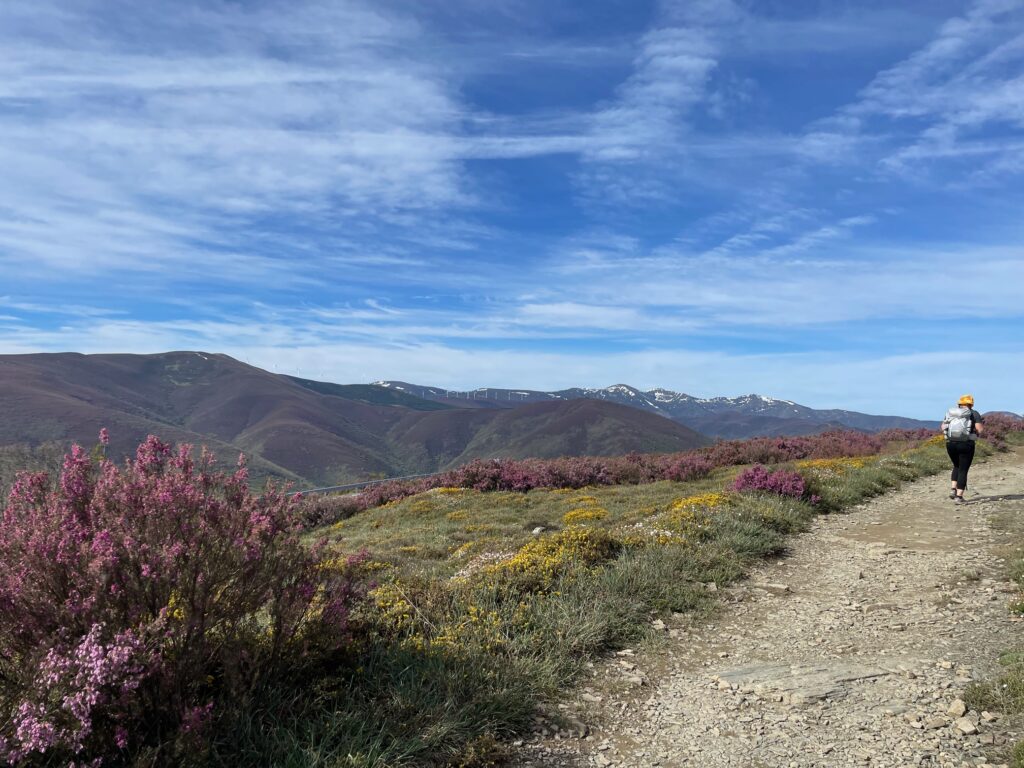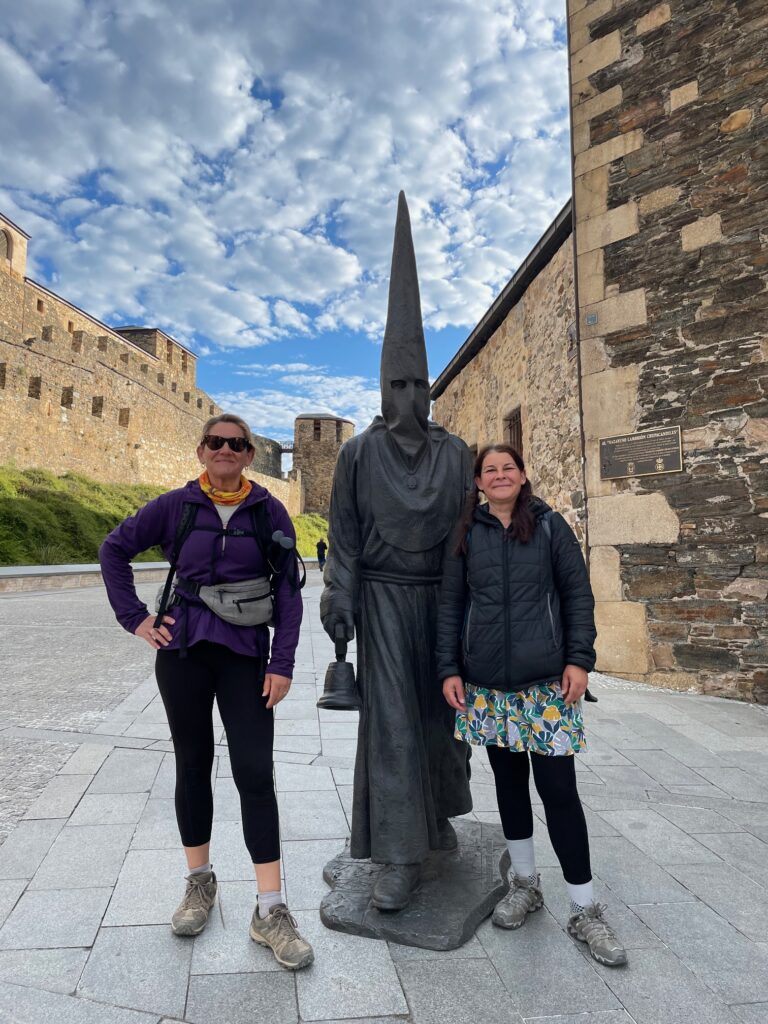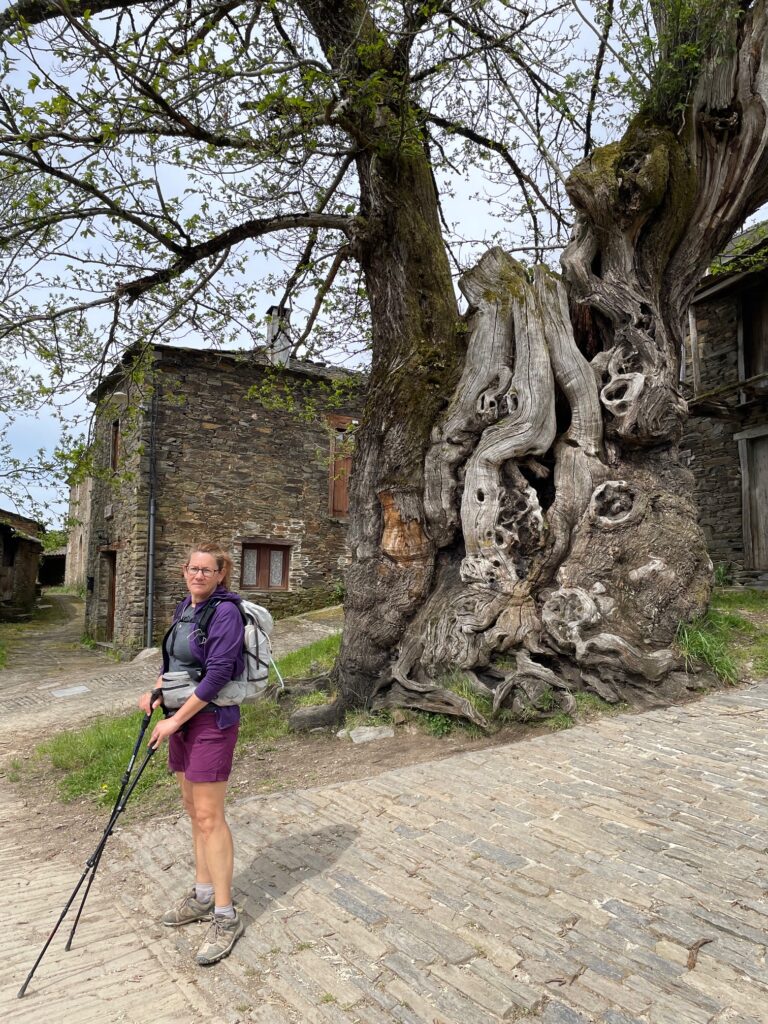Santibanez to Rabanal 30km, through Astorga
We spent a lovely evening in an old parish albergue run by the Italian Dominican order. It was old school. No heating, the showers and bathrooms were outside across the back garden, as was the sink for washing clothes. But it was very quiet and secluded.
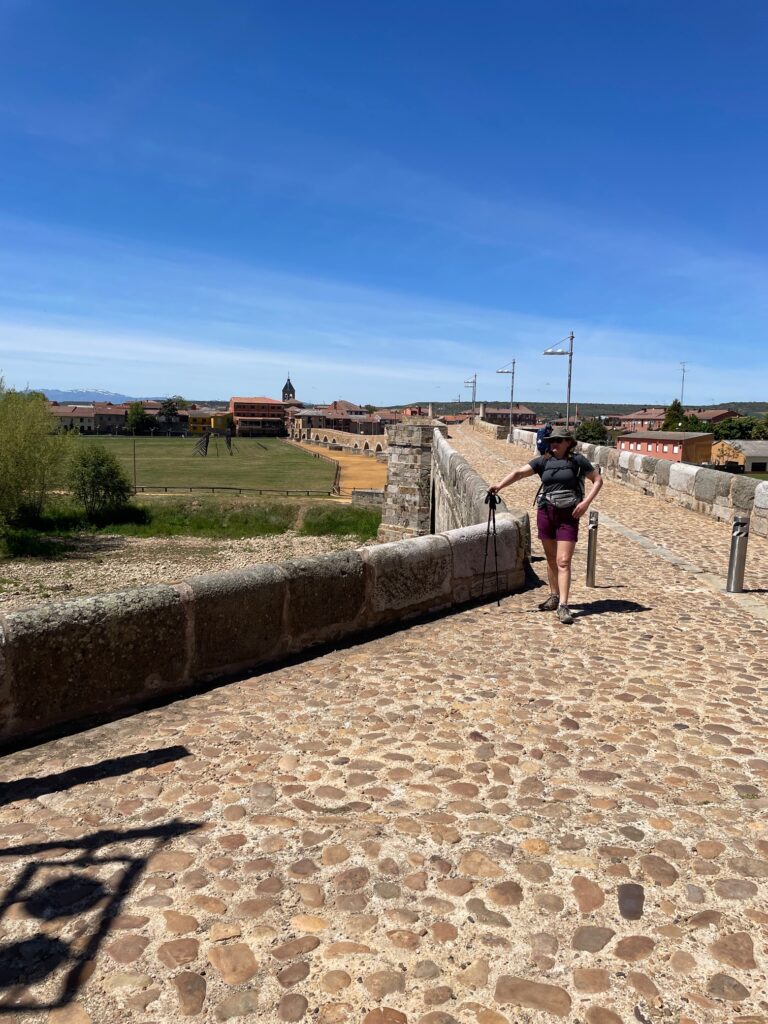
Our days walk took us past a donativo cafe where hot drinks, slices of watermelon, fruit and nuts, juice and hard boiled eggs were on offer, one just donated whatever they could. There was a sheltered bit with books and sofas, lounge chairs and crafted wooden tables. This was set up 14 years ago on the edge of a field in the middle of nowhere, 6km from Astorga. We met Jez from the Eastern Seaboard; he said he had a problem with remembering names; “Jo, as in my brother’s name, Terry, my dad is called Terry; ok, I should be able to remember that”. He didn’t. We met him several times a day for the next week and he recognised us but couldn’t recall our names. “Your dad’s name”, I would say the many times he asked.
Astorga was sensational; a town dedicated to chocolate with its own chocolate museum.
Rabanal was like Khao San road, Bangkok: All bustle and international joie de vivre; some Australian singer was doing a series of impromptu gigs in the Albergue we were staying at. Joyful singalong by middle aged trekkers, I’m sure that one of the theme songs for the Camino must be Eric Clapton’s “Knocking on Heaven’s Door”
Met refrigerator man and buddy; we shared some of our instant noodles with them; they commented on the general demographics of the Camino at the moment; the charm of the Australian singer was attracting a cohort of woman dans une certain age. I had to wait ten minutes for the outdoor clothes sink while two of them removed the last speck of dust and dirt from their already pristine shoes.
Rabanal to Molinseca, passing the Cruz de Ferro (the Iron Cross) 29km
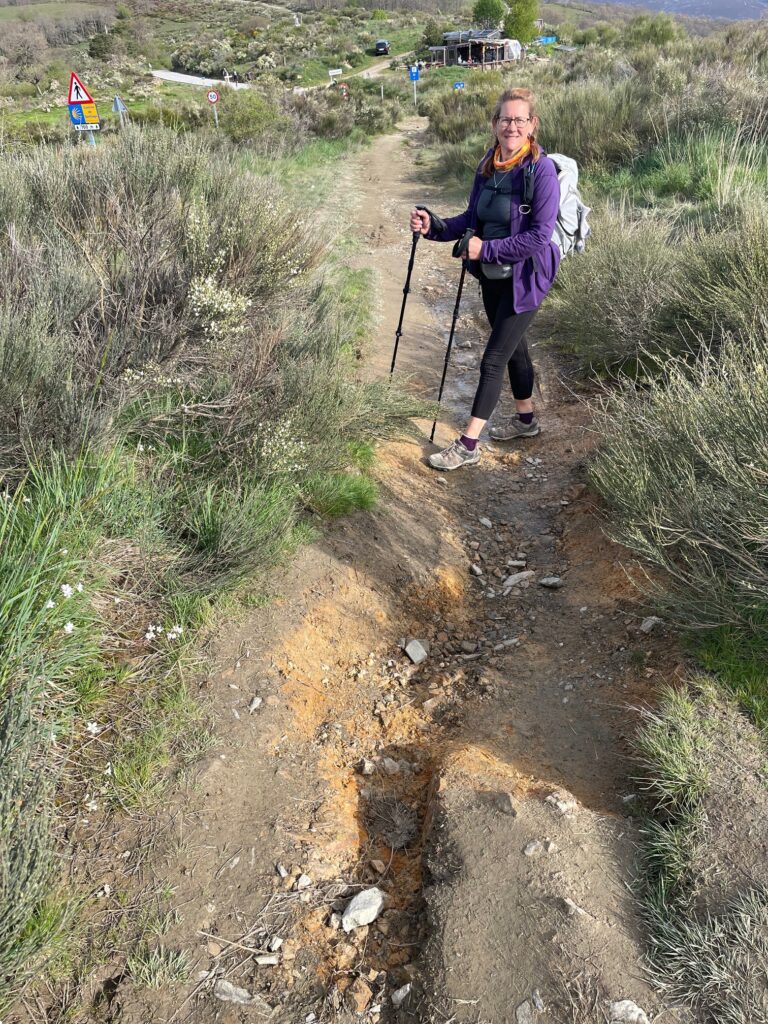
The path was steep and rough, some parts it was the small river bed, but the stream was shallow and our poles helped steady our feet. Until the mud claimed half of my pole. We managed to prised it out of the mud, without falling in. Jo, AKA Trail Warrior, was able to fix it back together without breaking stride.
Every colour was on the shrubs and mountain flowers, the sky turning from violet to pink, and Spain looking very grand and rich to the horizon in every direction.
I was thinking of what I would pray or intend once I got to the Iron Cross, so many threads of past and present swirled about in my mind that I couldn’t settle on anything; so I just tried to calm my mind and experience without words.
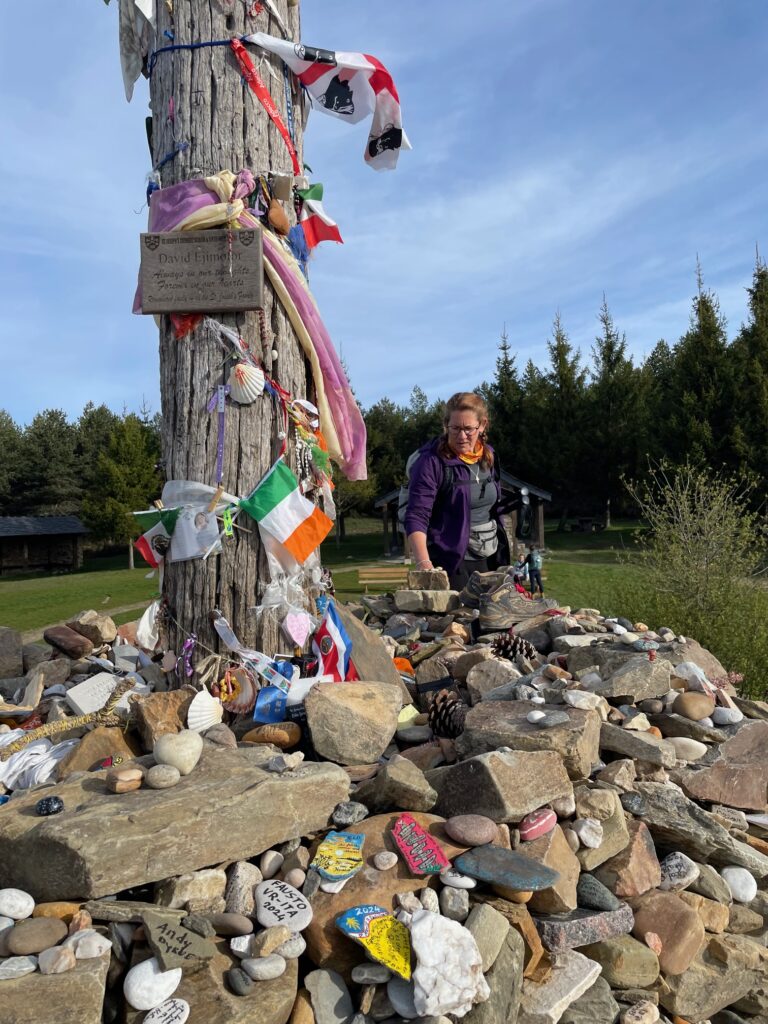
We arrived at the Cruz de Ferro at about 10am or so: This is an integral part of the Camino. In altitude and spiritually it is the high point of the pilgrimage. Tradition demands that the pilgrim brings a stone or small object from their home, to channel their burdens, their unresolved issues, a grief that cannot be assuaged, etc. into the rock, and then focus in acceptance and pray to God to relieve them of their burden, and grant His Grace and Mercy. Many pilgrims do the Camino after a death, divorce, job loss, indecision, addiction, or to resolve past trauma in general.
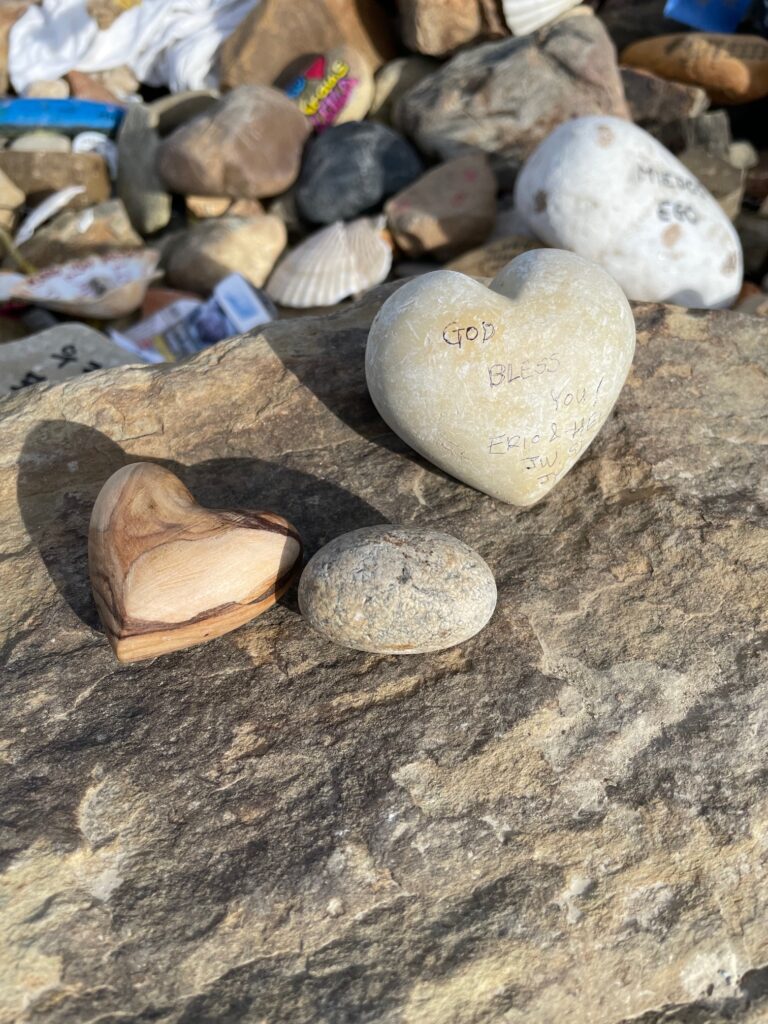
So it is a big deal. I had my stone, and Mary’s heart carved from olive wood; Jo had her stone. We approached the Iron Cross, up on a mound of stones, and perched around was a turret for offerings. There was a group of eight moped riders that had arrived before us and were shouting in joy. Then the other pilgrims were approaching one by one to lay their stone and say their prayers: the one behind offering to take a photo of the one in front when they were by the Cross. We waited patiently, behind a tiny old lady from Mexico. It was her turn, but as she solemnly approached, a cyclist zoomed up and jumped up the side of the mound. A chorus of muted outrage ensued as several different languages told him to get in line. Now. Which he did sharpish like, as no one wants angry pilgrims.
Even without the incident, it was difficult to get into a proper state of spiritual contemplation and catharsis, whilst waiting one’s turn like you were at the post office.
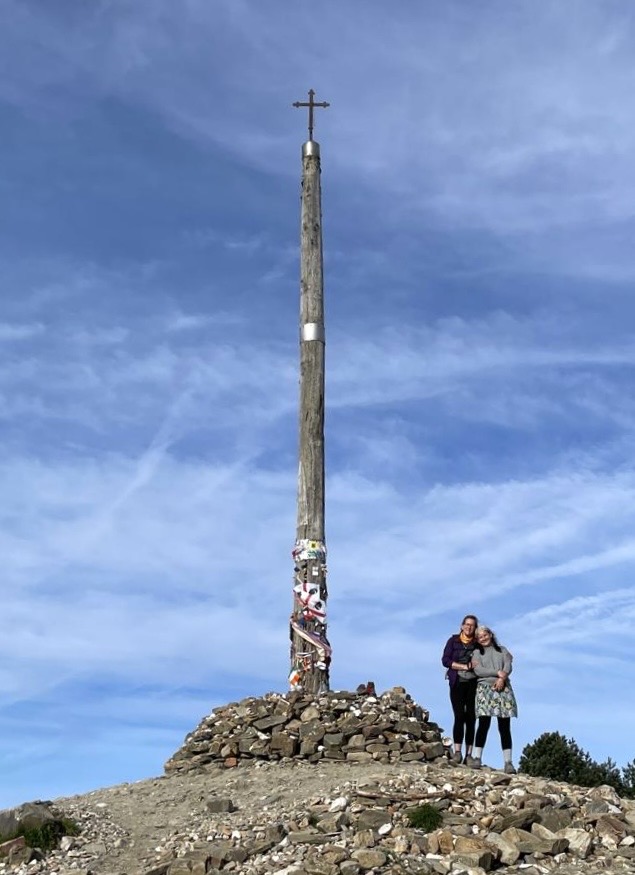
It was then across the rest of the mountain and down a vicious descent of slate, loose rubble and gullies; some parts were the river stream with water trickling over shiny stones, but shallow enough. Groups of pilgrims who had health issues, or who wished to avoid them, opted to walk along the road instead, which was not so steep or rough. We of course had no such regard for our cartilage and went for it. Although I have gotten better at keeping my knees flexed and using the poles, I still felt that descent for two nights afterwards in my hips. Even Jo commented that it wasn’t so easy.
The day was fine, not too hot; the shrubbery was in bloom, there were little blue butterflies and iridescent beetles like emeralds and rubies in flight. Whereas the broom was yellow budded in the valleys , they were replaced by white and then slopes of purple as we went up in altitude. Electric blue flowers and then dog roses, and a peppery sweet smell. All extremely beautiful.
Coming into Molinseca, pilgrims slumped by the terrace overlooking the river, we ate patates bravas and calimari with jugs of clara (like a shandy), and watched some of our cohort strip down to shorts and brave the river.
The taxis were doing a good trade picking up pilgrims who couldn’t make the day’s journey. There are lots of ads for taxis throughout the whole Camino, in the most remote places, stuck on sides of trees and on way markers. The taxi drivers must know the whole route like the back of their hand.
We were in a lovely dorm, just the two of us in a four person pod. We could hear Jez in the next dorm talking about his life in the army to the rest of his bunk mates.
Molinseca to Villafranca 30km
Today was cherry trees and roses all along the route which was supposed to be flat but had enough dips and heights to keep us from getting bored. Ate too much chocolate and churros first thing in the morning, so had just enough calories to last us the 30km trek to Villafranca. It is the prettiest village we have been to yet. We bought some rice and fish and I made dinner in the kitchen. We shared with some of the other pilgrims, and swapped stories over red wine.
Villafranca to O’Cebreiro 26km
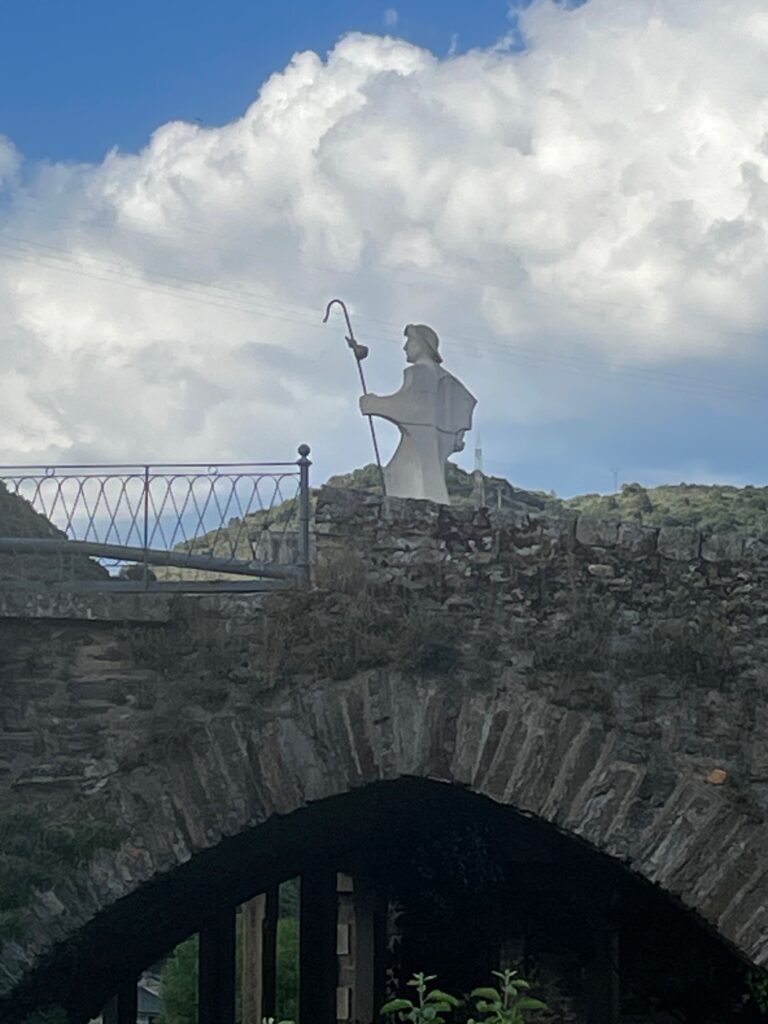
I was so tired, I woke up this morning feeling like I could have slept for another week. But up we were at 5.45 as usual, packing, eating breakfast, out the door while barely light to see by. Jo decided to basically run the first 13 kilometres; I struggled to keep up and got a bit cranky, as another blister bloomed. The last eight kilometres to O’Cebreiro was straight up on rough paths, some serious mud, as we gained 600 metres in altitude.
There was beautiful sunshine, not too hot; we have been diligent about using sunscreen etc, but are still ending up with truck drivers’ tans; along with the rest of the pilgrims, going due west all day does not give you even colouring.
I concentrated on the cherry trees, cows, and impressive panoramic views across and into Galicia.
In the smaller villages I noticed sprigs of plants pinned to doors or by windows. Apparently branches of olive, laurel and or rosemary are blessed on Palm Sunday and then used to ward off witches and the evil eye to protect houses, people and livestock.
O’Cebreiro is a tourist trap, we are in the municipal albergue which holds 104 people; it seems pretty full, I can hear a group of French people and some Italian. There’s no heating and this place offers no blankets, the first time on the Camino. I’ve got two T-shirts and my sweater on in my sleeping bag; but I’m still cold. The view outside the window is worth it, the mountains and valleys spread out from this high point; distant fields and vineyards falling into shadow as dusk approaches, but it is still sunny here.
